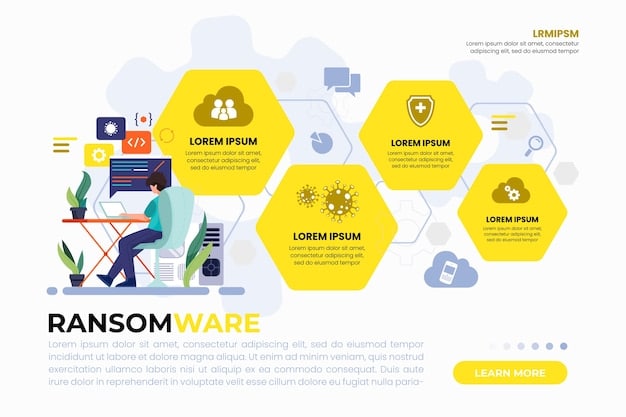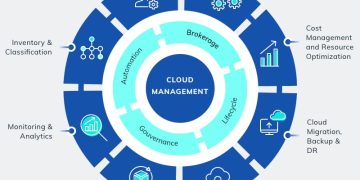Cloud Governance Frameworks: Best Practices in the US

Cloud governance frameworks are essential for organizations in the US to manage cloud resources effectively, ensuring security, compliance, and cost optimization while aligning with business goals.
In today’s digital landscape, cloud computing has become integral to business operations in the US. However, simply migrating to the cloud isn’t enough. Implementing robust **cloud governance frameworks** is crucial for ensuring that cloud resources are used effectively, securely, and in compliance with industry regulations and organizational policies.
Understanding cloud governance frameworks
Cloud governance frameworks provide a structured approach to managing and controlling cloud resources. They offer policies, procedures, and best practices that guide how organizations utilize cloud services, ensuring alignment with business objectives and regulatory requirements.
Why are cloud governance frameworks important?
Cloud governance frameworks are very important for several reasons. They are a set of guidelines, best practices, and rules designed to manage and use cloud resources efficiently and securely.
- Cost optimization: Cloud governance frameworks enable organizations to monitor and control cloud spending, preventing overspending and ensuring efficient resource allocation.
- Security and compliance: They enforce security policies and compliance standards, protecting sensitive data and ensuring adherence to regulations like HIPAA, GDPR, and PCI DSS.
- Risk management: Cloud governance frameworks help identify and mitigate potential risks associated with cloud adoption, such as data breaches, service outages, and compliance violations.
Without a well-defined **cloud governance framework**, organizations risk losing control of their cloud environment, leading to increased costs, security vulnerabilities, and compliance issues.

Key components of a cloud governance framework
A comprehensive cloud governance framework consists of several key components that work together to ensure effective cloud management. These components provide a structured approach to addressing various aspects of cloud adoption and utilization.
Policies and standards
Policies and standards define the rules and guidelines that govern cloud usage within an organization. They cover areas such as access control, data security, and resource allocation.
Policies must be clearly defined, communicated, and enforced to ensure consistent compliance across the organization. Regular reviews and updates are essential to keep policies aligned with evolving business needs and regulatory requirements.
Compliance and regulatory requirements
Compliance is a critical aspect of cloud governance, particularly for organizations operating in regulated industries. Cloud governance frameworks must incorporate mechanisms for ensuring adherence to relevant laws and regulations, such as HIPAA for healthcare and PCI DSS for financial services.
- Data privacy: Implementing policies and controls to protect sensitive data and comply with data privacy regulations like GDPR and CCPA.
- Security audits: Conducting regular security audits to identify vulnerabilities and ensure compliance with industry standards.
- Reporting: Establishing reporting mechanisms for tracking and documenting compliance efforts.
By proactively addressing compliance requirements, organizations can minimize the risk of penalties and maintain customer trust.
In conclusion, key components of **cloud governance frameworks** are very important to reduce and mitigate potential risks.
Implementing best practices in cloud governance
Implementing best practices is essential for maximizing the benefits of cloud governance and avoiding common pitfalls. These practices provide a roadmap for establishing and maintaining an effective cloud governance framework.
Establish a cloud governance team
Creating a dedicated cloud governance team is crucial for driving the implementation and enforcement of cloud governance policies. This team should include representatives from various departments, such as IT, security, compliance, and finance.
Define roles and responsibilities
Clearly defining roles and responsibilities within the cloud governance team is essential for ensuring accountability and effective decision-making. Each team member should have a specific set of responsibilities related to cloud governance.
- Cloud architect: Responsible for designing and implementing secure and scalable cloud solutions.
- Security officer: Oversees security policies and ensures compliance with industry standards.
- Compliance officer: Ensures adherence to relevant laws and regulations.
Properly implementing these best practices helps you have a much more organized and secure cloud system.
Cloud governance frameworks in the US: a closer look
Several cloud governance frameworks are widely used in the US. These frameworks offer organizations a structured approach to implementing and managing cloud governance.
NIST cloud computing reference architecture
The National Institute of Standards and Technology (NIST) Cloud Computing Reference Architecture provides a framework for understanding and implementing cloud computing services. It defines the key roles, activities, and components of a cloud environment.

Cloud security alliance (CSA) cloud controls matrix (CCM)
The Cloud Security Alliance (CSA) Cloud Controls Matrix (CCM) is a comprehensive framework of security controls for cloud computing. It covers a wide range of areas, including data security, identity management, and incident response.
COBIT (control objectives for information and related technologies)
COBIT (Control Objectives for Information and Related Technologies) is a framework for IT governance and management. While not specifically designed for cloud computing, COBIT can be adapted to address cloud governance requirements. COBIT can be used to govern IT, and although it was not created for specifically cloud computing, it might also be used for it. COBIT can be very useful in the long run.
The frameworks for **cloud governance frameworks** are very important in the US, thus, knowing them is very important.
Overcoming challenges in cloud governance
Implementing cloud governance can be challenging, particularly for organizations with complex IT environments or limited resources. However, by addressing these challenges proactively, organizations can increase their chances of success.
Lack of visibility
One of the biggest challenges in cloud governance is the lack of visibility into cloud resources and usage. Organizations may struggle to track cloud spending, monitor security risks, and ensure compliance with policies.
- Centralized dashboards: Implementing centralized dashboards that provide real-time visibility into cloud resources and usage.
- Automated monitoring: Using automated monitoring tools to detect anomalies and security threats.
- Cost management tools: Leveraging cost management tools to track cloud spending and identify opportunities for optimization.
To mitigate this challenge, tools and solutions like centralized dashboards should be implemented.
Future trends in cloud governance
Cloud governance is an evolving field, and several trends are shaping its future direction. Understanding these trends can help organizations prepare for the challenges and opportunities that lie ahead. Cloud governance is evolving, meaning new trends appear that must be followed.
Automation and artificial intelligence (AI)
Automation and AI are playing an increasingly important role in cloud governance. AI-powered tools can automate tasks such as security monitoring, compliance audits, and cost optimization, freeing up human resources and improving efficiency.
DevSecOps
DevSecOps is the integration of security practices into the DevOps lifecycle. It emphasizes the importance of incorporating security considerations early in the development process.
In conclusion, the future trends of **cloud governance frameworks** are very interesting and should be looked at.
| Key Point | Brief Description |
|---|---|
| 🛡️ Security Policies | Implementing strong security measures. |
| ✅ Compliance | Ensuring adherence to regulations like HIPAA. |
| 💰 Cost Optimization | Managing cloud expenses effectively. |
| 🤖 Automation | Using AI for tasks like security monitoring. |
FAQ
▼
Cloud governance frameworks are structured approaches that manage and control cloud resources, aligning them with business objectives and industry standards.
▼
It ensures security, compliance, and cost optimization in accordance with US regulations, protecting data and optimizing resource usage.
▼
NIST Cloud Computing Reference Architecture, CSA Cloud Controls Matrix (CCM), and COBIT are among the popular frameworks.
▼
Automation streamlines tasks such as security monitoring and cost optimization, increasing efficiency and minimizing human errors.
▼
Future trends include increased automation, the integration of AI, and the adoption of DevSecOps practices to enhance security and cooperation.
Conclusion
Implementing robust **cloud governance frameworks** is essential for organizations in the US to harness the full potential of cloud computing. By following best practices, addressing challenges proactively, and staying abreast of emerging trends, organizations can ensure that their cloud environments are secure, compliant, and aligned with their business objectives.





